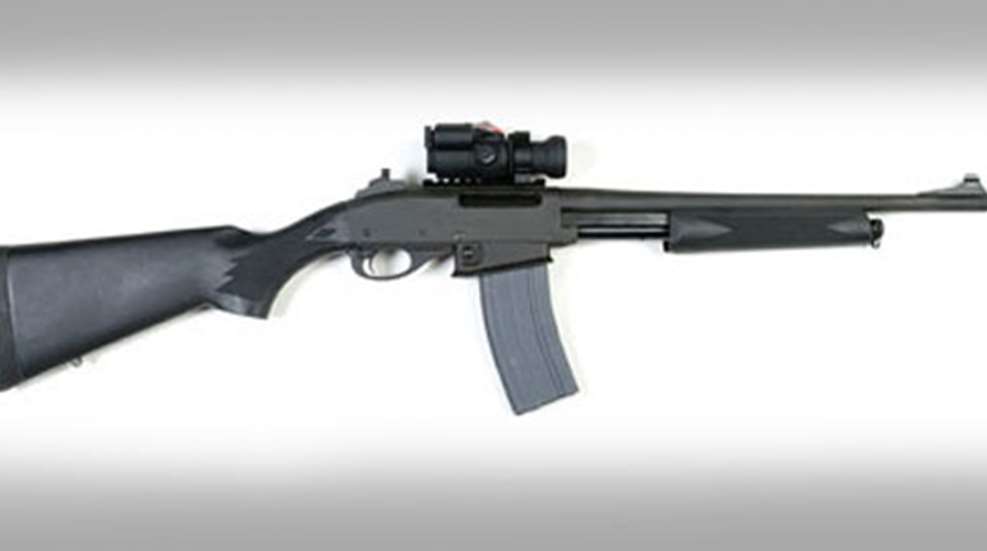
Although offering fast operation and simplicity of use, slide- or pump-action center-fire rifles are not nearly as common as their shotgun brethren. Within this niche market, however, the Remington 7600 series of center-fire rifles has proven to be one of the more popular because of its combination of user-friendliness and affordability. Recognizing the strengths of this rifle design, Remington’s Law Enforcement Division is offering two Duty/Patrol variants of the 7600 rifle: the 7600P in .308 Win. and the 7615P in .223 Rem., tested here. The 7615P is available through any distributor that carries Remington’s law enforcement line.
The 7615P offers similar operation to a standard Remington Model 870 with the same slide-action operation, cross-bolt safety at the rear of the trigger guard and slide action release at the front of the trigger guard. According to Remington, these similarities have made for significantly easier transitioning from the 870 for officers who may not have had much prior experience with rifles. Apparently, the .223 Rem. chambering has also made it popular with smaller-statured officers who are uncomfortable with the recoil of a 12-ga. Model 870.
The basic 7600 series of rifles—although similar to the Model 870 in appearance and use—differs significantly in design, utilizing a rotating bolt that locks into a barrel extension. The 7600’s barrel, fitted through a barrel bracket at the front of the rifle’s steel receiver, screws into a barrel extension that houses the recesses for the locking lugs.
The 7615P is a variant of the standard Remington Model 7600, however, it offers some distinct changes from the standard rifle. First and foremost of these—as well as being the most obvious—is the extended magazine-well adapter forward of the trigger guard. The standard 7600 series of rifles is designed to accept detachable, proprietary magazines whose limited-capacity may make them less than ideal for law enforcement or self-defense. The 7615P features a synthetic adapter factory fitted into the magazine well of the rifle that allows the use of AR-15/M16 magazines.
Although it appears to be oversize, the outside width of the adapter is the same size as a standard, Remington 7600 proprietary magazine. This means that basically the only modification required for the receiver was a hole on its right side to accept a screw that holds in the adapter.
Although not immediately obvious, the second significant alteration is the number of locking lugs on the 7615P’s bolt. While a standard 7600 has four locking lugs, this rifle has only three. The absence of the fourth lug, normally positioned at the lowest position when the action is open, allows clearance for the magazine-well adapter and magazine system. Remington assured us that this does not in any way reduce or compromise the strength of the locked action, and in our tests, we did not have any problems.
Other qualities, such as its Parkerized finish and synthetic stock and foreend, bring the rifle more in line with the rest of Remington’s law enforcement products. The 7615P is offered with a standard set of rifle sights, with both the front and rear sight mounted on the barrel. There is also a Wilson Combat ghost-ring-sight model that has the rear sight mounted on the receiver. We received the latter model for testing. Additionally, the receiver is drilled and tapped for a scope mount, and Leupold offers a Picatinny rail for the receiver.
The rifle itself is extremely handy with a short but stout 16 ½-inch barrel that measures 1.17 inches in diameter just forward of the receiver. The finish on the rifle was evenly applied and attractively flat. For accuracy testing, we mounted a Trijicon TriPower low over the receiver, which allowed for a comfortable cheek weld.
The rifle was pleasant to shoot due to its .223 Rem. chambering and 7-pound weight, andit functioned perfectly in both accuracy testing and rapid-fire strings.
Althoughthe 7615P is offered as part of Remington’s law enforcement product line, it will likely appeal to civilian shooters as it is ideal as a handy, portable ranch-type long arm that utilizes a commonly available magazine.
Manufacturer: Remington Arms Company, Inc. (Dept. AR), P.O. Box 700, Madison, NC 27025-0700; (800) 243-9700; www.remingtonle.com
Caliber: 5.56 mm NATO/.223 Rem.
Action Type: slide action, center-fire rifle
Receiver: Parkerized carbon steel
Barrel: 16 1/2" Parkerized carbon steel
Rifling: six groove, 1:9" RH twist
Magazine: detachable AR-15/M16 box magazine
Sights: Wilson Combat ghost-ring rear, XS Sight Systems bead front (tested)
Trigger Pull: two-stage, 6 lbs.,12 ozs.
Stock: length of pull, 14"; drop at heel, 2 1/2"; drop at comb, 1 1/2"
Overall Length: 37 1/2"
Weight: 7 lbs.
Accessories: 10-round magazine, instruction manual
Suggested Retail Price: $750 (tested), $675 with rifle sight





































